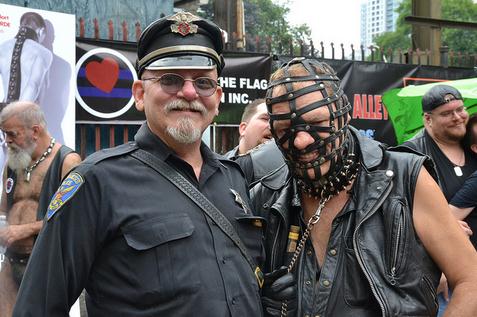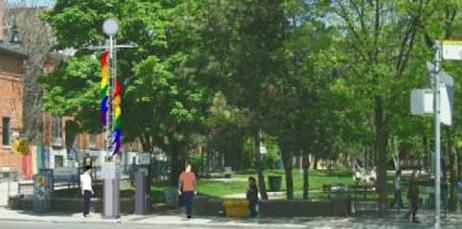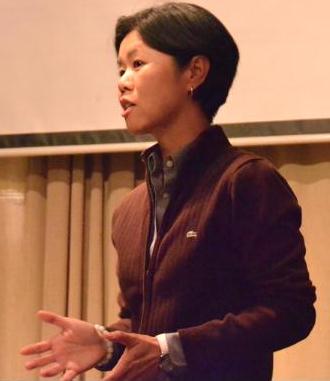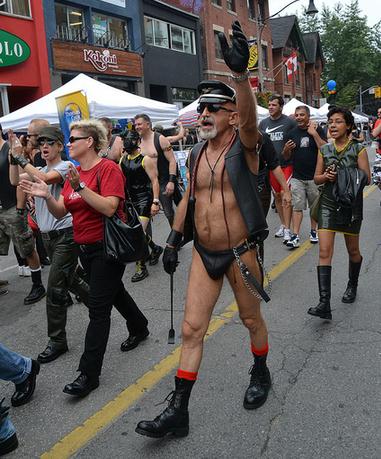
Fun on the patio at Zipperz after marching through the Village Fair in 2011. Credit: Andrea Houston

The BIA set aside $87,500 in its 2012 budget for two 22-foot rainbow-swirl signpost markers, the cost of two Fetish Fairs. It's unclear when the posts will be installed. Credit: Andrea Houston

Councillor Kristyn Wong-Tam answers questions at the BIA's annual general meeting in November. Credit: Andrea Houston

Marching through the Village Fair in 2011. Credit: Andrea Houston
The co-chair of the Church and Wellesley Village Business Improvement Area (BIA) says local merchants are adapting to a changing neighbourhood. Just don’t call it “family-friendly.”
BIA manager David Wootton, who did not return Xtra‘s calls, recently wrote an email to Xtra to express disappointment that the words “family-friendly” were used to describe the BIA’s decision to cancel its annual Fetish Fair and replace it with “inclusive events,” such as a sidewalk sale. “Fetish Fair as we know it ended last year,” Wootton said in March.
Liz Devine, the BIA co-chair and the president of Rainbow High Vacations on Church St, says merchants have been making an effort to appeal to families, among other people, in recent years.
“We would rather call it neighbourhood-friendly, community-inclusive, ” Devine says.
Those aren’t the words George Giaouris, owner of Northbound Leather on Yonge St, uses. “Let’s call this what it is,” he says. “Trying to soften the Fetish Fair and put in bouncy castles, like they did last year, it killed it. When you’re thinking fetish, you don’t want little kids running around. So I think the BIA made a bad move. Put the family event on another weekend.”
The cancellation of Fetish Fair is a major blow, he says, and signals the “desexifying” of the Village. “This is yet another unique experience that has been removed from the list of reasons to go to the Village,” he says. “The more the neighbourhood is homogenized, the more bland it becomes, and the less interesting.”
Giaouris, who “lives Fetish Fair 365 days a year,” says the event has always been very well attended, profitable, unique — and it attracted people to the Village.
That’s not actually the case, Devine says. “Most businesses were either closed or reported decreased business on Fetish Fair day. Very few BIA businesses participated as vendors in the Fetish Fair.” However, she could not provide a number to indicate how many vendors are members of the BIA.
Other Church St businesses have mixed feelings. Terry Barlows, a bartender at O’Grady’s, says business, especially on the patio, is steady during Fetish Fair. “It’s busy out there because we’re right next to the staging area . . . Fetish Fair is an event that brings in tourism. I talk with people at the bar. Lots of people say they’re from the States.”
Across the street, at the Churchmouse and Firkin pub, assistant manager David Pistilli says he’s not the least bit surprised the BIA chose to cancel Fetish Fair. “The money just wasn’t there. People weren’t spending.”
Pistilli, who counts himself a proud member of the leather community and is a former employee of Northbound Leather, says he’s saddened the Fetish Fair wasn’t more profitable for area businesses. “Overall, I think the leather business has declined everywhere. Maybe fetish people are staying home, having private parties or turning to the internet.”
Steamworks general manager John Broadhagen, a long-time sponsor of Fetish Fair who sits on the BIA board, says Fetish Fair wasn’t very popular with some merchants. “Many of the business owners on Church St are straight. And they don’t get the whole fetish thing.”
The BIA plans to replace the fair with new events it says will be more welcoming to those outside the gay community, Devine says, such as families living in the new condo towers. The weekend events throughout August, which may or may not include a sidewalk sale, will not have anything to do with fetish or kink.
“Our neighbourhood is changing pretty dramatically and the BIA is quite aware of that,” Devine says. “The eight-block radius surrounding the Village is changing with all of the new condominium construction.”
Since Loblaws has moved into the neighbourhood, small Church St businesses have been struggling. “You’re seeing the gentrification of the whole downtown district. On Church St, small independent stores are moving out. Xtra moved off Church St and is being replaced by a medical centre. That reflects the changing demographic,” she says.
However, the BIA set aside $87,500 in its 2012 budget for two new 22-foot rainbow-swirl signpost markers to welcome visitors to the Village. For Broadhagen, the posts represent the BIA investing a lot of money to maintain the image of the Village as a queer area, but he says the unspoken truth is that it’s quickly changing. “We have to protect our history and culture here. We are supposed to be the gay neighbourhood. We should be doing gay-related events, things that appeal to the queer community.”
While he didn’t have an exact date, Broadhagen says the rainbow markers will be installed at either end of Church St soon. “I think [the markers] are a lot of money for what we’re getting. The cost of Fetish Fair is a drop in the bucket really. But with so many people opposed to it, it’s tough to keep it going.”
The BIA is trying to reshape the community, Broadhagen says. “Are we really a family community? Sure, there’s gay families, gay marriage and gay adoption, but, come on, there are not a lot of kids here. So is [the BIA] making the best move? I don’t think so, but that’s just my personal opinion. I was disappointed. Steamworks was a big supporter of Fetish Fair . . . To lose that event for this community is a shame.”
Ward 27 Councillor Kristyn Wong-Tam says there’s no shame in the BIA’s decision to let go of Fetish Fair. “That had a lot to do with economics and volunteer energy . . . Perhaps they just need to scale it down. It was very ambitious. That might have been an option rather than cancelling it altogether.”
There is a long history of mixed messages and attitudes about the Fetish Fair.
Last year the festival got a makeover. The Church St Fetish Fair was rebranded as the Church St Village Fair. At the time co-chair Avery Pitcher told Xtra the BIA wanted the event to be more “inclusive and geared to all ages.”
But not everyone wanted to see the event rebranded. To protest the change, a large group of leather and kinky folk marched through the fair, chanting, “This is what Leather Pride looks like!” Giaouris says the leather community spoke loud and clear.
“That was a slap to the BIA,” Broadhagen says, adding, “I have a strong leather background . . . I didn’t like that [the leather and fetish folks] were segregated last year. I spoke out against it. I know the BIA sees me as the bad boy on the board. It’s a board of middle-aged, mostly straight business owners in the community.”
Devine says the change was necessary because businesses along Church St were not reporting much profit. She says a BIA exists to serve its members, who are the local businesses that provide the association with annual funding, not the community at large.
“The purpose of the BIA is to promote a healthy and sustainable business district,” she says. “[Preserving the sex-positive image of the Village] isn’t the responsibility of the BIA. It’s a broader responsibility of the community.”
Throughout its seven-year history, the Fetish Fair has faced several threats, yet Wootton had always insisted the BIA supported the festival.
In 2010 he told Xtra that Fetish Fair is an integral part of the Village. He said, “The fair has a political agenda. It does brand this neighbourhood — it keeps the sex in the Village. We need to keep a certain amount of that so that members of the global community know we still identify with sexual freedom and sexual practice.”
However, that same year, Wootton also admitted that some area businesses do not want to be associated with fetish or sex.
In 2009, the Fetish Fair was in danger of a funding cut, so the event’s former executive director, Cam Lewis, and other organizers lobbied the board and area merchants.
“Fully funding the Fetish Fair was a no-brainer,” Lewis, who declined to comment, told Xtra at the time. “After all, the Fetish Fair brings people to the Village, elevates the gayness of the Village; it drives business to [BIA] members, it showcases local talent, and it is the second largest outdoor fair in the Village. Only Pride is bigger.”
Devine disagrees, however, noting the BIA has tried several times to tap into corporate sponsorship for the Fetish Fair but has been unsuccessful. “It’s a difficult event to sell.”
According to its budget summary, $40,000 was allocated to the fair in 2011. But Devine says it actually cost between $60,000 and $70,000. “As a result of that, the BIA has no funds, like zero, to do any neighbourhood marketing initiatives.”
The total BIA levy for 2012 is $233,730, up from $231,933 in 2011.
Wong-Tam says the BIA should be working on getting the neighbourhood prepared for the international spotlight of WorldPride in 2014. “Wisely, the BIA wants to focus on streetscaping and beautifying the area to get it ready for WorldPride. That is a strategic direction. We have a world signature event coming to Church St in just two years.”

 Why you can trust Xtra
Why you can trust Xtra


